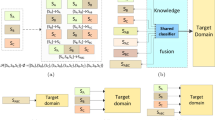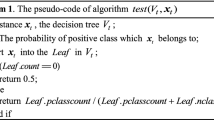Abstract
Transfer learning aims to enhance performance in a target domain by exploiting useful information from auxiliary or source domains when the labeled data in the target domain are insufficient or difficult to acquire. In some real-world applications, the data of source domain are provided in advance, but the data of target domain may arrive in a stream fashion. This kind of problem is known as online transfer learning. In practice, there can be several source domains that are related to the target domain. The performance of online transfer learning is highly associated with selected source domains, and simply combining the source domains may lead to unsatisfactory performance. In this paper, we seek to promote classification performance in a target domain by leveraging labeled data from multiple source domains in online setting. To achieve this, we propose a new online transfer learning algorithm that merges and leverages the classifiers of the source and target domain with an ensemble method. The mistake bound of the proposed algorithm is analyzed, and the comprehensive experiments on three real-world data sets illustrate that our algorithm outperforms the compared baseline algorithms.






Similar content being viewed by others
References
Amini M, Usunier N, Goutte C (2009) Learning from multiple partially observed views-an application to multilingual text categorization. In: Advances in neural information processing systems, pp 28–36
Chattopadhyay R, Sun Q, Fan W, Davidson I, Panchanathan S, Ye J (2012) Multisource domain adaptation and its application to early detection of fatigue. ACM Trans Knowl Discov Data 6(4):18
Crammer K, Dekel O, Keshet J, Shalev-Shwartz S, Singer Y (2006) Online passive-aggressive algorithms. J Mach Learn Res 7:551–585
Dredze M, Crammer K, Pereira F (2008) Confidence-weighted linear classification. In: Proceedings of the 25th international conference on machine learning. ACM, pp 264–271
Dredze M, Kulesza A, Crammer K (2010) Multi-domain learning by confidence-weighted parameter combination. Mach Learn 79(1–2):123–149
Duan L, Tsang IW, Xu D, Chua T-S (2009) Domain adaptation from multiple sources via auxiliary classifiers. In: Proceedings of the 26th annual international conference on machine learning. ACM, pp 289–296
Eaton E, des Jardins M (2011) Selective transfer between learning tasks using task-based boosting. In: AAAI
Freund Y, Schapire RE (1997) A decision-theoretic generalization of on-line learning and an application to boosting. J Comput Syst Sci 55(1):119–139
Freund Y, Schapire RE (1999) Large margin classification using the perceptron algorithm. Mach Learn 37(3):277–296
Ge L, Gao J, Zhang A (2013) OMS-TL: A framework of online multiple source transfer learning. In: Proceedings of the 22nd ACM international conference on Information and knowledge management. ACM, pp 2423–2428
Han C, Tan Y-K, Zhu J-H, Guo Y, Chen J, Qing-Yao W (2016) Online feature selection of class imbalance via pa algorithm. J Comput Sci Technol 31(4):673–682
Hoi SCH, Wang J, Zhao P (2014) Libol: a library for online learning algorithms. J Mach Learn Res 15(1):495–499
Li G, Hoi SCH, Chang K, Liu W, Jain R (2014) Collaborative online multitask learning. IEEE Trans Knowl Data Eng 26(8):1866–1876
Ng MK, Wu Q, Ye Y (2012) Co-transfer learning via joint transition probability graph based method. In: Proceedings of the 1st international workshop on cross domain knowledge discovery in web and social network mining, pp 1–9
Pan SJ, Yang Q (2010) A survey on transfer learning. IEEE Trans Knowl Data Eng 22(10):1345–1359
Rosenblatt F (1958) The perceptron: a probabilistic model for information storage and organization in the brain. Psychol Rev 65(6):386
Schölkopf B, Herbrich R, Smola AJ (2001) A generalized representer theorem. In: Computational learning theory. Springer, pp 416–426
Shalev-Shwartz S, Singer Y (2007) Online learning: theory, algorithms, and applications
Wang J, Zhao P, Hoi SCH (2012) Exact soft confidence-weighted learning. arXiv preprint arXiv:1206.4612
Wang J, Hoi SCH, Zhao P, Liu Z-Y (2013) Online multi-task collaborative filtering for on-the-fly recommender systems. In: Proceedings of the 7th ACM conference on recommender systems. ACM, pp 237–244
Wu Q, Ng MK, Ye Y (2014) Cotransfer learning using coupled markov chains with restart. IEEE Intell Syst 29(4):26–33
Xindong W, Chen H, Gongqing W, Liu J, Zheng Q, He X, Zhao Z-Q, Wei B, Li Y, Zhang Q et al (2015) Knowledge engineering with big data. IEEE Intell Syst 30(5):46–55
Xiang EW, Pan SJ, Pan W, Su J, Yang Q (2011) Source-selection-free transfer learning. In: IJCAI proceedings-international joint conference on artificial intelligence, vol 22, p 2355
Yan Y, Wu Q, Tan M, Min H (2016) Online heterogeneous transfer learning by weighted offline and online classifiers. In: Proceedings of the 14th European conference on computer vision (ECCV) workshops, pp 467–474
Yao Y, Doretto G (2010) Boosting for transfer learning with multiple sources. In: Computer vision and pattern recognition (CVPR), 2010 IEEE conference on, pp 855–1862. IEEE
Zhao P, Hoi SC (2010) OTL: a framework of online transfer learning. In: Proceedings of the 27th international conference on machine learning (ICML-10), pp 1231–1238
Zhao P, Hoi SCH, Wang J, Li B (2014) Online transfer learning. Artif Intell 216:76–102
Acknowledgements
Y. Yan and H. Wu are the corresponding authors. The authors would like to thank the reviewers for their useful and constructive suggestions. This research was supported by the Guangzhou Key Laboratory of Robotics and Intelligent Software under Grant No. 15180007, and National Natural Science Foundation of China (NSFC) Under Grant No. 61502177.
Author information
Authors and Affiliations
Corresponding authors
Additional information
Qingyao Wu, Xiaoming Zhou: Co-first author.
Rights and permissions
About this article
Cite this article
Wu, Q., Zhou, X., Yan, Y. et al. Online transfer learning by leveraging multiple source domains. Knowl Inf Syst 52, 687–707 (2017). https://doi.org/10.1007/s10115-016-1021-1
Received:
Accepted:
Published:
Issue Date:
DOI: https://doi.org/10.1007/s10115-016-1021-1




